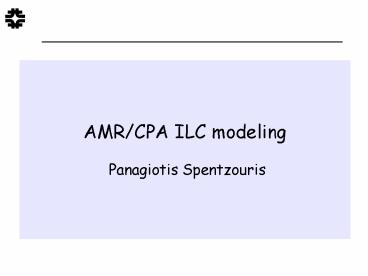AMRCPA ILC modeling
1 / 16
Title:
AMRCPA ILC modeling
Description:
a Tesla cavity from VORPAL. Access to state-of-the-art codes through SciDAC ... VORPAL crab cavity modeling. E-transverse. E-axial. Outlook ... –
Number of Views:54
Avg rating:3.0/5.0
Title: AMRCPA ILC modeling
1
AMR/CPA ILC modeling Panagiotis Spentzouris
2
Accelerator Simulation in CPA
- Our activities focus on developing and applying
(few, selected applications) accelerator
modelling capabilities, utilizing (when
possible) existing codes (SciDAC project
leveraged) - Multi-particle dynamics framework (5 years)
- Parallel computing
- Single particle optics libraries (15 years!)
- Emphasis on infrastructure and move towards
producing user oriented software
3
Resources
- L. Michelotti (optics applications), J.
Amundson (parallel framework, multi-particle
dynamics applications), E. Stern
(multi-particle dynamics applications), D.
Dechow (frameworks visitor-), V. Ivanov
(electromagnetics, optics), P. Spentzouris
(multi-particle dynamics applications). - Also, utilize external resources
SciDAC collaboration (members since '01) develop
apply parallel community codes for design and
operation optimization. Funds received June
'05-June '06 150k 1 FNAL resident collaborator
funded by a phase-II SBIR (TechX) SciDAC-2
proposal submitted (FNAL lead institution)
Phase-I SBIR (starts Oct '06) awarded (Tech-X)
4
Examples of '06 activities
- Utilize mature 3D space-charge capabilities
- Study Booster losses ILC Damping Ring
- Validate beam-beam 3D multi-bunch model
- Apply to Tevatron potentially ILC IP
- Start gaining experience in e-cloud modeling
- Main Injector upgrades, also targeting ILC
Damping Ring - Develop expertise in ILC Low Emittance Transport
design - Adapt CHEF (ILC applications in Paul's talk)
- Release Synergia2 (parallel framework)
- Multi-physics capabilities
- Begun Electromagnetics modeling (ILC crab cavity)
5
CHEF
- Mature beam physics software originally
developed for protons - Recent emphasis on packaging and user interface
- Extended CHEF libraries to handle electrons and
ILC specific physics requirements (cavities,
wakefields) - Applied to
- ILC LET (see P.Lebrun's talk)
- ILC DR
- CHEF libraries are also used for single
- particle optics in Synergia
Collaborative Hierarchical Expandable Framework
arbitrary order Lie maps (single particle
optics) MAD parser automatic differentiation,
numerical integration.
6
Beam-beam
- 3D, multi-bunch, multi-IP capabilities
- Utilize BeamBeam3D (SciDAC), adapt for Tev
requirements - Realistic lattice, multi-bunch/IP scheme
- Model validation
- Relevant to ILC IP (requires development)
2-bunch coherent 4-bunch coherent
7
Fermilab SciDAC product Synergia
Synergia2 released in '06
- Synergia1 emphasis on user interface and
space-charge - Synergia2 flexible efficient
- Multi-physics realistic models
- State of the art numerical libraries, solvers,
physics modules
Synergia1 mature code (JCP '06) Participated in
international space-charge benchmark effort
lead by I.Hofmann (GSI) (PAC'05)
Synergia2 will be used in JHF MR commissioning!
8
Synergia activity highlights
- Synergia used to study Booster halo creation
emittance dilution - Beam studies, turn-by-turn profiles (IPM, our
calibration PRSTAB '03) - 3D model enables study of phase space
correlations - Study dynamic apperture
- Fully 3D Damping Ring space-charge CSR modeling
3D Booster simulation including injection, rf
ramping, etc. Comparison with experimental data
New technique for halo characterization using
beam shape (submitted to PRSTAB)
9
PCAC Cluster
Parallel Cluster for Accelerator Computations
- CPUs
- 48 dual Xeon 2.4 GHz
- up and running
- 20 dual Xeon 3.2 Ghz (ILC)
- not yet installed/configured
- Networking
- Myrinet in all machines
- 80-port Myrinet switch
- Head nodes
- 2 dual Xeon 3.0 GHz
- 1 more on order
10
Synergia performance
- Utilized NERSC SP3 and Linux clusters
- Studies of parallel performance
- Case-by-case optimization
- Optimization of particle tracking
11
Electron cloud simulations
- Develop Synergia module based on txphysics
- Begun studying cloud generation for MI upgrade
- Begun studies of e-cloud effects in beam dynamics
using QuickPIC (SciDAC, working with USC) - Very important effect in ILC DR design!
MI upgrade e-cloud creation
12
ILC DR modeling status
- Objective is multi-physics modeling
- Begun lattice studies (CHEF)
- Develop CSR module for CHEF
- Expand cluster for DR dedicated studies (20
nodes)
G.I. CHEF DR lattice
13
ILC DR studies with CHEF
14
Electromagnetics
- Access to state-of-the-art codes through SciDAC
- Develop local expertise (newly hired guest
scientist) - Provide simulation support to ILC crab cavity
design - If SciDAC-2 proposal successful, expand wakefield
calculations to ML and DR - Use in beam dynamics model
- Design support(if SciDAC2)
- HIGHLY LEVERAGED!
15
VORPAL crab cavity modeling
E-transverse
E-axial
16
Outlook
- Wealth of expertise but capabilities are manpower
limited - Could efficiently utilize postdocs
- Emphasis on multi-particle, multi-physics ILC
simulations - Space-charge impedance CSR (ILC DR)
- Beam-beam quantum effects (ILC linac)
- E-cloud generation dynamics space-charge (ILC
DR, MI) - Wakefield calculation
- For beam dynamics design
- Develop apply generalized steering package for
ILC studies
Require SciDAC2 or equivalent additional resources































